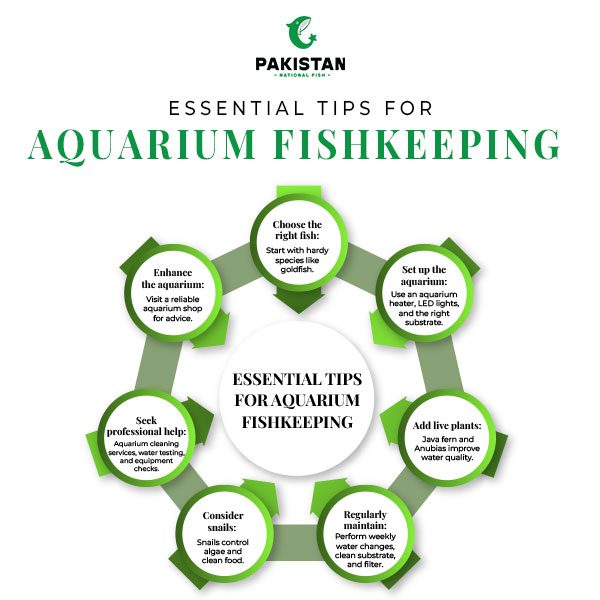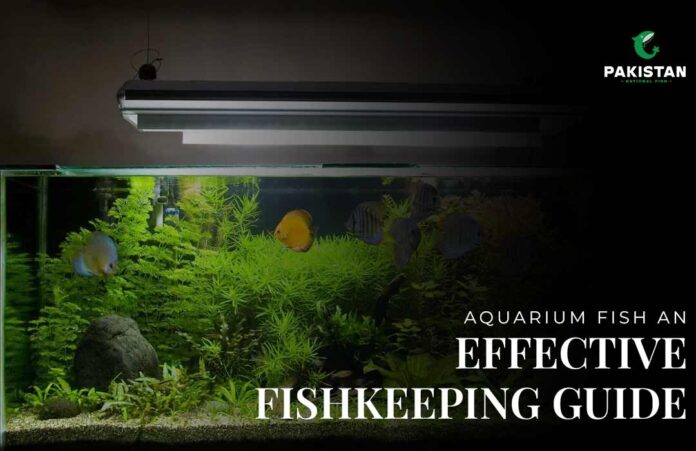You may bring a little bit of underwater life into your home with the enjoyable and fulfilling hobby of aquarium fishkeeping. Your fish will thrive if you know the fundamentals of aquarium maintenance, whether you’re an experienced hobbyist or just getting started. Choosing the appropriate fish and plants to keeping your aquarium clean and healthy are all covered in this tutorial.

CHOOSING THE BEST FISH FOR YOUR AQUARIUM
Choosing the proper fish is essential when starting a fish keeping hobby. For example, goldfish are a popular choice among novices because of their vivid colors and hardiness. But it’s important to learn about the requirements of each species; certain fish have particular needs in terms of companions, tank size, and water quality.
FISH AQUARIUM GOLDFISH
The first fish that typically spring to mind when someone thinks of aquariums are goldfish. They are rather simple to maintain, but they require a large tank in them to flourish. Panda goldfish under stress and with poor water quality might result from overcrowding a tank. Make sure your aquarium has adequate room and a suitable filtration system before adding goldfish
FISH KEEPING: A LIFELONG HOBBY
- Turns from simple hobby to lifelong passion.
- Enjoys creating diverse aquatic environment.
- Explores various species, tank setups, and fish breeding.
- Engages with fish keeping community for insights and tips.
AQUARIUM SETUP: HEATERS, LIGHTS, AND SOIL
- Aquarium Heaters: Maintain stable water temperature for fish well-being. Fluctuations can lead to stress and disease.
- Aquarium Lights: Support growth of live aquarium plants and regulate fish’s biological rhythms. LED lights are popular due to their energy efficiency and customizable settings.
- Aquarium Soil and Plants: Provide a base for plants to root and influence water chemistry. Choose the right soil for live aquarium plants to enhance beauty and maintain water quality.
- Live Aquarium Plants: Provide shelter for fish, improve water quality, and create a natural environment. Ensure proper soil and lighting support plant growth.
AQUARIUM MAINTENANCE SERVICE: KEEPING IT CLEAN
- Regular cleaning and water parameters monitoring are crucial for fish health.
- Regular water changes, including removing 20-30% of water weekly, remove waste and toxins.
- Vacuuming the substrate and cleaning the filter prevent debris and uneaten food from polluting the tank.
- Aquarium cleaning service can help maintain the tank’s condition, prevent issues like algae overgrowth, and improve water quality.
- Maintenance services include water testing, equipment checks, and fish health assessments.
AQUARIUM FILTRATION: THE CENTRAL MECHANISM OF A HEALTHY AQUARIUM
An aquarium’s ability to filter water is one of its most important features. In addition to maintaining clear water, a high-quality filtration system maintains the biological balance your fish need to be healthy.
AQUARIUM FILTERS TYPES
Mechanical Filters:
- Remove uneaten food, fish waste, and plant debris from water.
- Work by passing water through a medium like sponge or filter floss.
- Regular cleaning or replacement is essential for efficiency.
Biological Filters:
- Use beneficial bacteria to convert harmful ammonia and nitrite into less toxic nitrate.
- Colonize filter media, substrate, and other tank surfaces.
- Crucial for maintaining a stable and healthy fish environment.
Chemical Filters:
- Use activated carbon or other media to remove dissolved impurities like toxins, medications, and odors.
AQUARIUM CYCLING: SETTING UP YOUR FISH TANK
It’s imperative to cycle the aquarium before introducing fish. Beneficial bacteria colonized by the cycling process are essential for converting poisonous ammonia to nitrite and subsequently to nitrate.
Nitrogen Cycle in Aquariums
- Natural process in all aquariums.
- Initial setup lacks bacteria for ammonia processing.
- Bacteria colonize filter media and substrate, converting ammonia to nitrite and nitrate.
- Cycle completion is crucial before fish introduction to prevent toxic spikes.
HOW TO CYCLE AN AQUARIUM
- Set up the tank with substrate, plants, and equipment.
- Add ammonia to the tank to initiate the cycle.
- Monitor water levels using a test kit.
- Be patient, cycling can take 4-6 weeks.
- Avoid adding fish until ammonia and nitrite levels are zero and nitrate levels are low.
SELECTING THE IDEAL FILTER FOR YOUR FISH TANK
Depending on the size of your tank, the kind of fish you keep, and your maintenance requirements, you can choose the best filter. A canister filter is better suited for larger installations, although a hang-on-back filter might work well in a small to medium-sized tank. Make sure the filter you select can manage the volume of the tank and has sufficient water circulation.
ENHANCING AQUARIUMS: SNAILS, SHOPS, AND GIFTS
Aquarium Snails:
- Control algae and clean up uneaten food.
- Contribute to tank cleanliness.
- Choose right snail species to avoid breeding nuisances.
Aquarium Shops:
- Source healthy fish, plants, and equipment from a reputable aquarium shop.
- Offer variety of species and expert advice.
- Discover new aquarium additions and keep fish healthy.
Gifts for a Child Who Likes Marine Life and Aquariums:
- Starter fish tanks.
- Aquarium-themed books.
- Interactive fish keeping kits.
- Nurture interest and teach responsibility.
COMMON DISEASES OF AQUARIUM FISH AND HOW TO AVOID THEM
You should keep an eye out for any symptoms of illness in your fish in order to maintain a healthy aquarium. In order to stop infections from spreading, early detection and timely treatment are essential.
- COMMON FISH DISEASES
- Ich (White Spot Disease): A parasitic disease causing white spots on fish’s body and fins. Highly contagious and fatal if untreated. Raising water temperature and using commercial ich treatment can eradicate it.
- Fin Rot: A bacterial infection causing fin fraying and disintegration. Caused by poor water quality or stress. Improved water conditions and antibiotic treatment can cure it.
- Swim Bladder Disease: Affects fish’s buoyancy control, causing abnormal float or sink. Caused by overfeeding, constipation, or bacterial infections. Fasting and high-fiber diet can alleviate symptoms.
PREVENTING FISH DISEASES
- Regular water changes, proper filtration, and monitoring of water parameters are crucial.
- Quarantine new fish for at least two weeks before adding them to the main tank.
- Avoid overcrowding to prevent stress, poor water quality, and increased disease susceptibility.
- Feed a balanced diet to ensure necessary nutrients for fish health.
THE CHEMISTRY OF AQUARIUM WATER: THE SECRET TO HEALTHY FISH
The chemistry of the water is essential to keeping an aquarium healthy. Certain water parameters are necessary for fish and plants to be healthy, and being aware of these characteristics can help avoid frequent issues.
IMPORTANT WATER PARAMETERS FOR FISHING
pH Levels:
- Measures the acidity or alkalinity of aquarium water.
- Most freshwater fish thrive in pH range of 6.5 to 7.5.
- Regular testing with a test kit helps maintain stable conditions.
- Adjustments can be made with commercial pH adjusters or natural methods.
- Toxic to fish and should be kept at zero.
- Nitrate, the end product of the nitrogen cycle, should be kept below 40 ppm.
- General Hardness (GH) refers to the concentration of calcium and magnesium ions in the water.
- Adjustments can be made using specific aquarium additives or by mixing tap water with distilled or RO water.
- Tropical fish require temperatures between 75°F and 80°F.
- Cold-water species like goldfish prefer cooler conditions.
- An aquarium heater with a thermostat helps maintain stable temperatures.
CONCLUSION: THE JOY OF FISH KEEPING
Fishkeeping is an exploration of the wonderful world of aquatic life, not just a hobby. You can give your fish a healthy habitat by carefully setting up your aquarium and giving it regular maintenance. In the world of aquariums, there’s always something new to discover and learn, regardless of expertise level.


